Collage is the official 2006 English language translation of a 2004 freeware Japanese visual novel of the same year. The original Japanese Collage was released by a visual novel circle called Komineto. It was translated into English by AstCd2 and submitted to the al|together 2006 visual novel translation festival. I am reviewing Collage as part of my project to review nearly all of the 31 freeware Japanese visual novels translated for the 2005, 2006, and 2008 al|together festivals. Collage is my 21st review of the project.

You can learn more about my al|together project by reading my project introduction article. That article includes a running list of our completed al|together reviews. I have a dedicated collection post with links to all of our al|together articles, including reviews, essays, and short posts.
Collage is one of the most unique entries to al|together, both in terms of its style and its structure. The player begins the story from the perspective of Yuuko Sasaki, a young woman (probably close to 30) who quits her job after taking revenge on her boss by revealing his embezzlement and then must figure out what to do next. We follow Yuuko as she reconnects with a former high school classmate and with a friend from college, and through these connections she, and we, meet more people. Over the course of Collage, we see the story from perspectives other than Yuuko’s and learn that these seemingly unrelated characters’stories may be more intertwined than they seem. Collage has a colorful UI and lively, modern background music playlist. It is certainly one of the better al|together entries, and I will explain why below in my review.
Collage Details
English version
| Title | Collage |
| Translator | AstCd2 |
| Release Date | August 19, 2006 |
| Engine | KiriKiri |
| Official Website | al|together 2006 |
Japanese original
| Title | Collage |
| Developer | Komineto |
| Release Date | May 10, 2004 |
| Engine | KiriKiri |
| Official Website | Archived |
| Original Download | Archived, but works |

Installing and Running Collage
Collage is one of the small numbers of al|together visual novels written in the KiriKiri scripting language (the majority were written in NScripter in Japanese and early versions of ONScripter-EN in English). Like its fellow KiriKiri translations, including Summer, Cicadas, and the Girl and Until We Meet Again, the English version of Collage requires a Japanese language environment to run. Unlike the ONScripter-EN translations, Collage is only available natively for Windows.
I ran Collage on Linux on top of WINE using Lutris as my graphical WINE helper. For those interested in running Collage on Linux with the help of WINE, I wrote a guide to configuring a Japanese language environment in PlayOnLinux, Lutris, and Bottles (I used Lutris to run Collage, but I also successfully tested it in Bottles). One minor issue with Collage is that it also needs Japanese fonts to render the English text correctly. Some other KiriKiri-powered al|together games I reviewed rendered correctly when I installed Japanese fonts. However, in Collage, the display was still off. I ended up temporarily installing the fonts provided by from The Moe Way (note: I just dropped them in my ~/.fonts directory) which resolved the issue.
Other than the font, I had two minor issues running Collage on top of WINE. On one occasion, I the game became non-responsive when I tried to save. On a couple of occasions, I had to launch it twice for it to run. However, other than those issues, Collage ran without problems for the 3-4 hours I spent with it.
General overview of Collage
The al|together 2006 festival page for Collage includes the translator’s introduction:
Three ordinary people are thrown together, and each retells events in his or her own voice in this unconventionally told, uniquely presented, and ultimately very human novella.
The game begins with the player taking the perspective of Yuuko Sasaki, who is most likely in her late 20s. She complains about various aspects of her life, including her boyfriend breaking up with her to be with the daughter of a corporate executive and also her boss, who acts abusively toward subordinates and specifically singles her out for vitriol. Upon arriving at work one day, Yuuko first confronts her boss with her findings that he had embezzled funds, and she then quits her job (she had apparently spent a few weeks investigating her boss so she could take revenge on him on her way out).

Yuuko then goes to a bar where she drinks too much before being recognized by a high school classmate, Jun Maejima. Jun, seeing Yuuko’s state, takes Yuuko home with her and allows her to spend the night.

Upon waking up, Yuuko meets Maria Sakamaki, a six-year old girl whose mother had recently passed away. Maria, not happy with her strict grandfather, ran away from home to stay with Jun, was had been her late mother’s best friend. We learn that Jun and Maria are looking for Maria’s father, who her mother had apparently named in a letter. Yuuko had not been close to Jun in high school (we learn that Yuuko had been popular and Jun had been a loner), but they get along well and Yuuko is struck by how different Jun seems as an adult than she had seemed in high school.

After parting with Jun, Yuuko, inspired by the chance encounter, recalls that her best friend from college who she had fallen out of touch with also lived near the area. She calls Miki Nishino, who is excited to hear from Yuuko, and Jun decides to drop by for a visit.
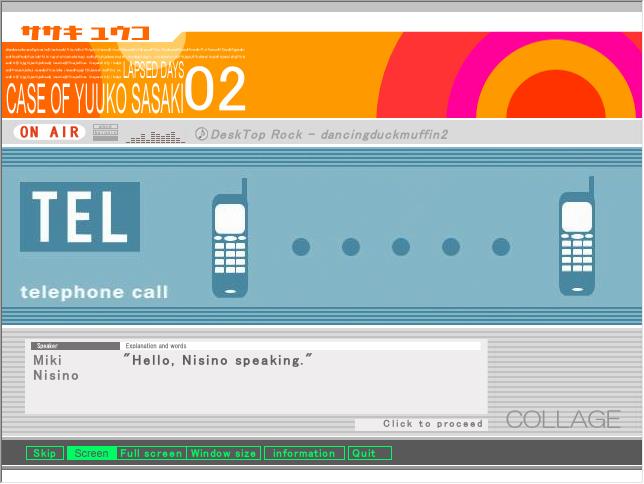
Over the course of the story, a few additional key characters are introduced. At first, there is no reason to assume that these seemingly unrelated people have connections with one another separate from their individual relationships with Yuuko.
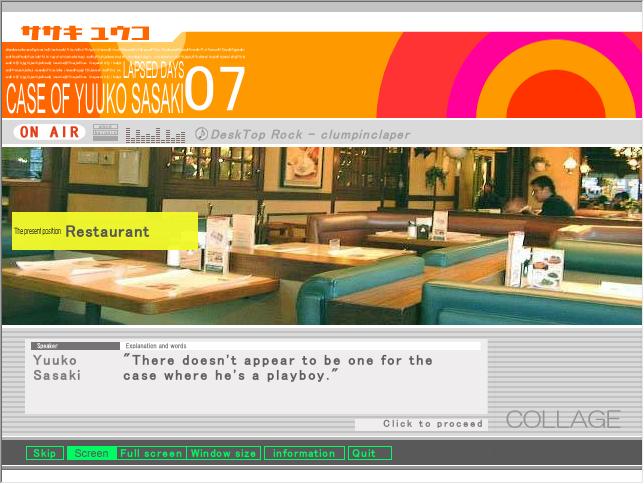
However, over the course of the story, we learn that there are connections unknown to Yuuko, and new connections are created by the independent actions of the different characters. Moreover, after a point, the story’s viewpoint shifts from Yuuko to another character. Still later, we see events from the perspective of a third character. The collage (for lack of a better term) of characters and events ultimately pieces together into a unified story made from many different threads.
Collage Review
Collage is a long, very story-driven game. I think it is a good game and I hope that some people who read this review will take the time to install and read through Collage on their own. I generally write reviews of visual novels in such a way to not spoil key events of the story. In some cases, such as Crimsoness, which is a three-minute visual novel about a school girl working to destroy the planet, this was not difficult. Collage presents a trickier challenge.
The al|together 2006 page for Collage notes that the novel has three view-point characters. For the purpose of this review, I will restrict my discussion of specific events and use of screenshots to the first set of chapters narrated by Yuuko Sasaki. I will not specify which characters serve as the second and third narrators later in the story.
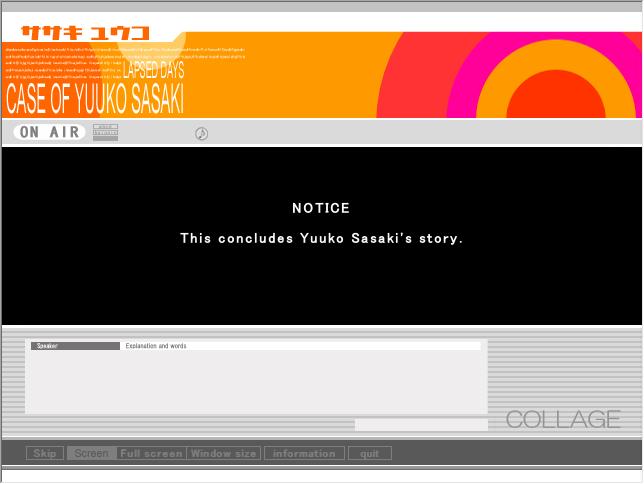
Leaving the specifics to the early Yuuko Sasaki chapters is more than enough to introduce Collage and its themes. Thus, you will not see any screenshots from the chapters seen from the perspective of the other two principal view-point characters.
Estimated reading time
Collage is one of the longer al|together novels. I will venture that it should take most readers somewhere close to 4 hours, give or take a bit either way, to read through once. Extra play time can be added by testing out bad choices or spending some time with the jukebox on the start menu. Play time can also be affected by how quickly players read through scenes that they previously saw from the perspective of Yuuko or another of the other two view-point characters but that are shown a second time from the perspective of a different character.
Game-play and structure
Collage has many in-game choices and the most choices of any al|together novel that I have reviewed thus far, surpassing fellow 2006 entry Night of the Forget-Me-Nots. However, unlike Night of the Forget-Me-Nots, which had more than 20 endings resulting from its many choices, Collage’s narrative is effectively linear, and all of its choices are of the survive-and-advance variety that we saw in al|together 2005 entry Plain Song and in a non-al|together commercial visual novel called Bad End. The creator, Komineto, explained this in the Readme (this is a text file in the game’s installation directory):
At certain points, you will be presented with a choice. In order to proceed, click on the option you prefer. There will generally only be two choices to select from. Choosing the wrong one leads to what is pretty much an instant game over, so there’s not a lot of room to play around (^^;
Collage Readme
Indeed this is the case. The correct choice advances the story to the next chapter. The wrong choice leads to a short dialogue and a game over.
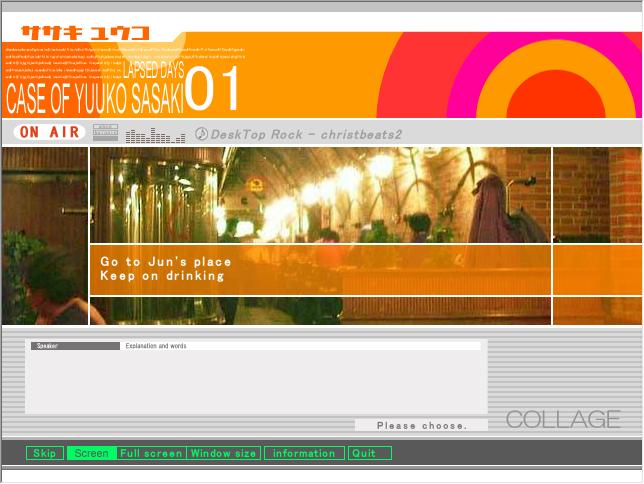
Many, if not most of the choices, are innocuous. It may seem odd that one wrong choice leads to a bad ending. However, when one considers the intricate weaving of narratives in Collage and the number of very specific events and encounters that occur to ultimately tie the disparate character stories together, the necessity of making specific choices and taking specific actions to achieve the ultimate outcome of Collage makes some sense.
Collage is structured in chapters. In general, each chapter covers one day, but the days are not indexed to specific dates in the same way that we saw in May Sky. To use Yuuko as an example since I used the beginning of her first arc to introduce the story, chapter 1, or day 1, is the day on which she quits her job and meets Jun at the bar. On chapter 2, or day 2, she meets Maria, spends the day with Jun, and then visits Miki. The game follows this pattern. When the perspective shifts from Yuuko perspective to that of the next character, the game begins from that character’s first chapter. When we eventually return to Yuuko later in the game, Collage resumes with the chapter number following the chapter at which the viewpoint shift away from Yuuko’s story had occurred.off.
There is no player interaction in Collage beyond regularly making these choices.
Choice difficulty assessment
Provided that the reader understands that there is always one correct choice, choosing the correct choice is usually easy. Collage is a game about connections and trying new things, and there is usually one choice that corresponds with the theme. There were a couple of instances when I thought that the choice was not entirely obvious, but I only unintentionally made the wrong choice on one occasion out of many.
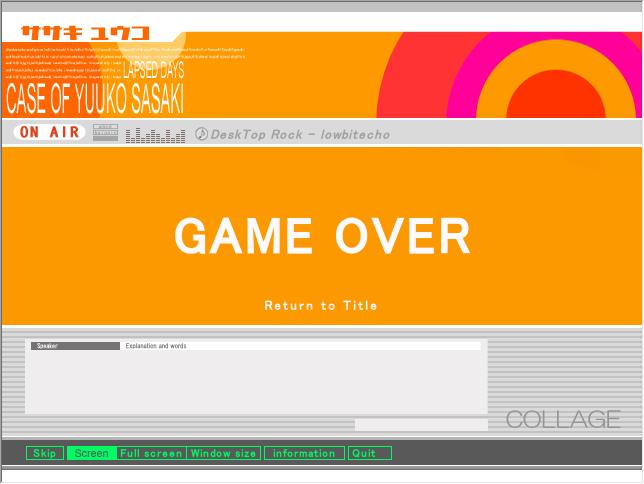
Having tested some wrong choices, I will note that a wrong choice sometimes makes an implicit connection explicit before it is stated clearly in the story. That is, something which has been hinted at may be made clear in the text between a wrong choice and a bad ending even before the characters see the connection clearly in the events of the game.
Visual presentation
Collage is one of the most unique looking al|together visual novels, and I will venture it may have benefited from the flexibility provided by KiriKiri in comparison to NScripter.
The screen is roughly separated into five rows. The top row has a nice design and notes the view-point character next to the chapter number. Because all of our screenshots are from the Yuuki Sasaki chapters, all of our captures will read “CASE OF YUUKO SASAKI” next to the chapter number.
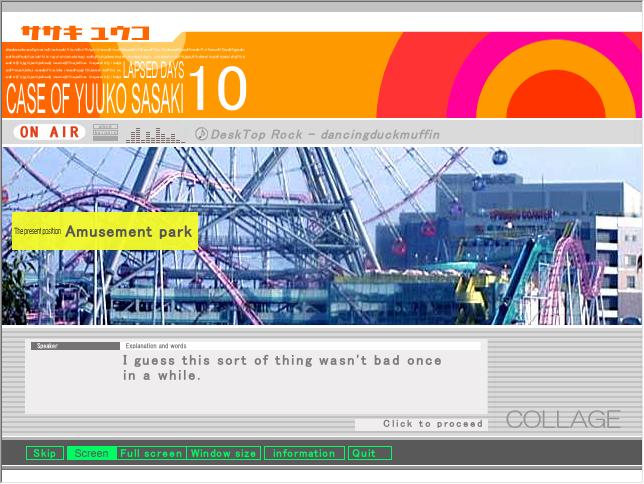
We have a nice flourish in the second row. Here, we have “ON AIR” text next to the name of the currently playing song. The game notes the song playing and the song’s creator. If one enjoys a particular song, he or she can note the name and find it in the novel’s music menu on the title page.
The dominant part of the screen is the middle section, which features familiar visual novel background art. Collage has no character portraits, and scenes are depicted by real photographs used as backgrounds. Overlaying the backgrounds is a yellow box noting “The present position.” The use of free-to-use photographs as backgrounds is common in the al|together visual novels, but Collage is among the best at the art-form.
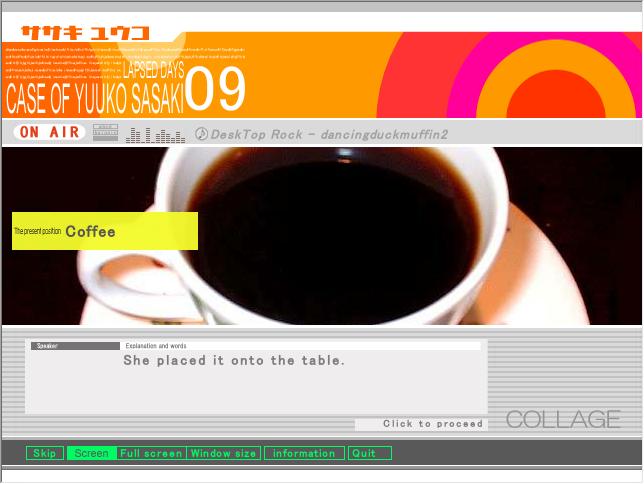
While I did not keep track of the exact number of backgrounds, I was both surprised and impressed with how many backgrounds Collage has and its attention to detail in using stock photographs. Each background is used for only one location. For example, there are multiple tea houses (note: they seem more like coffee shops to me, but the characters refer to them as tea houses). Many novels of this type would use a single background to demonstrate a tea house. Not so with Collage. Each tea house has a different background, and the same applies to other location types such as multiple offices, apartments, kitchens, diners, and the like.
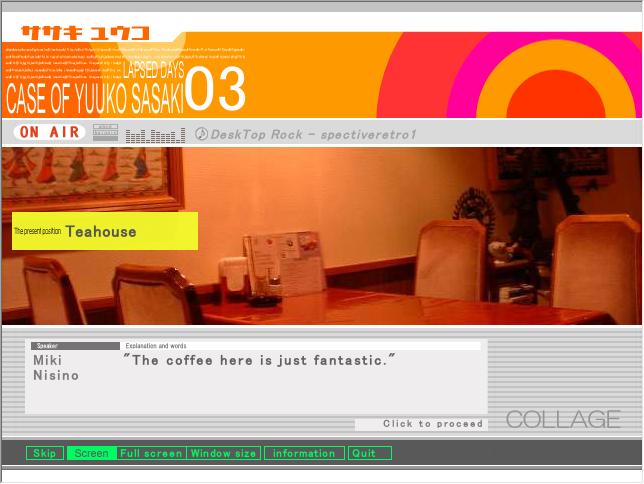
The only time backgrounds repeat is when you are returning to a location where you have previously been e. This consistency is significant in a few scenes involving a train station.
The text box is below the background. The identity of the speaker is positioned to the left of the text. This too is implemented with careful attention to detail. When there is no identified speaker, the text is in the head of the view-point character. For example, in a Yuuko Sasaki chapter where there is text but no speaker, we know that we are reading the thoughts of Yuuko. When there is an identified speaker, we know who is actually speaking.
Finally, the bottom of every screen features an easy-to-access options menu, with the most significant option being Skip. Interestingly, saving and loading are only accessible via the right click menu.
While Collage’s visuals are simple, few if any al|together novels put more careful work into the presentation. The colors fit the story’s young urban theme and mesh will with the music, which I will discuss in the next sub-section. With the exception of al|together 2005’s Until We Meet Again, no al|together visual novel has made better use of stock photographs, and the sheer variety that Collage uses not only shows impressive attention to detail, but also makes it easier to tie together events across stories separately told by three narrators.
Music and sound
The first song which plays in Collage is called wetandheavy by DeskTop Rock. It sounds like something straight out of one of my favorite video games of all time, Persona 3, and I felt a bit nostalgic right off the top . Collage features an in-game jukebox (accessible from the start menu) listing all of its tracks with credits and allowing readers to play them at leisure:
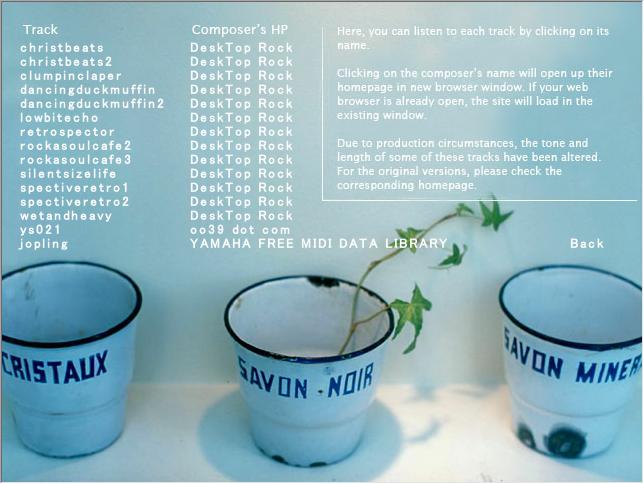
Collage has sixteen tracks. While this is above the norm for an al|together novel, it is not a large number given that Collage is relatively long. Moreover, most of the tracks loop after about 10 seconds, meaning that we do not have full songs presented as in many of the other novels (the DeskTop Rock collection, specifically). However, notwithstanding these limitations, Collage makes effective use of what it has.
Firstly, all of the tracks fit into Collage’s young, modern (for 2004, of course), and urban aesthetic. Secondly, Collage mixes up the tracks very effectively and makes good choices for particular scenes, which makes the music seem less repetitive than it otherwise might. Thirdly, while most of the tracks loop repeatedly, Collage tends to keep its individual scenes short, even within chapters, meaning that it moves from one track to the next at a good pace.
The stand-out tracks (exempting ys021 which is used for the end credits) are wetandheavy, retrospector, and clumpinclaper.
Collage also makes limited use of sound effects. There are occasional door bells and phones ringing. The most notable effect is the sound of a rewinding audio tape when a character digs into his or her own recent recollections.
Collage makes good use of free-to-use music in the same way that it made good use of free-to-use photos for the backgrounds. The tracks, combined with the photos and the colorful UI, give Collage a distinct and memorable urban aesthetic.
Notes on saving and loading
There are a few interesting and unusual points about saving and loading in Collage.
Firstly, the concept of chapters is important to how loading from saves works in Collage. I quote from the creator’s Readme:
You can save and load by right clicking and following the menu. Please note that saves will only be made at the beginning of each calendar day within the game. If you save at any other point, you will begin at the start of that day when you load.
Collage Readme
In short, if I make a save during Yuuko’s chapter 3, loading from that save will always load from the beginning of chapter 3. I could make three saves at different points in chapter three, but loading will always take the player to the beginning of the chapter.
Secondly, you can actually take text notes on your save file. See below for an example:

I made some use of the note feature to highlight important events and choices in scenes for purpose of putting together this review.
Collage comes with 28 save slots. While this is a solid number, I would have preferred more because it falls well short of enough save points to maintain saves for every chapter in Collage. At a minimum, I recommend limiting saves to every six chapters or so and also at the first chapter on each occasion that the view-point character shifts. Keeping regular saves is also a hedge against inadvertently making an incorrect choice. However, Collage’s skip feature works well for quickly speeding through text.
Translation quality of Collage
As always, I preface my translation quality review by noting that I do not read Japanese. Thus, my translation commentary is restricted to opining on how the game reads in English.
Collage is one of the best-reading translations of the al|together set. There were a small number of instances where I thought something read a bit clunky, but the dialogue is overwhelmingly fluid and the characters express complicated emotions and inhibitions in sophisticated ways. The translator, AstCd2, produced the translation of A Winter’s Tale (which we reviewed) for al|together 2005, and I noted in my review that A Winter’s Tale stood out among many good translations for how well it reads in English. I dare say Collage is an even more impressive effort given its length and the number of characters.
I will note one interesting issue I had. I noted that several characters whose names looked like they should have an “h” in them did not. For example, take Miki Nishino, a character I mentioned previously in the review. On my screen, Nishino was rendered as Nisino. I had seen enough English renditions of Japanese names to have the distinct feeling that a letter was missing there, but I was not entirely sure. I started to wonder when another character had a similar issue. Visual Novel Database lists all these characters with the “h’s” that I thought were missing, e.g., Nishino. I am not sure if this is how they are supposed to be written in the translation or if I had a font issue. However, for the purpose of this review, I used the Visual Novel Database spelling.
Writing and story quality
Collage is one of the most down-to-Earth al|together stories, covering a couple of weeks in the lives of ordinary working adults in their late 20s/early 30s. Through its use of different perspectives and its consistent interest in exploring the connections of its cast, it proves to be one of the most compelling al|together projects, albeit not without some flaws.
Although Collage ultimately has three view-point characters and the three view-point characters have almost the same number of chapters, Yuuko Sakaki is princeps inter pares in terms of telling the story. Yuuko’s decision to quit her job in a blaze of glory, which has nothing at all to do with any of the other characters in Collage, sets off a chain of events that changes the lives of the other main characters of the story. Yuuko, who is portrayed as smart, headstrong, opinionated, well-meaning, and blunt, certainly did not plan to have a series of chance encounters with people from her past, nor did she expect to get roped into work that is very different than what she had been doing before.
The unexpected events are triggered in part by Yuuko having always made a strong impression on people. Jun recognizes Yuuko at a bar despite the fact that they had not been close in high school because, we learn, that Jun had admired Yuuko in high school (and later perhaps Yuuko had become closer to the kind of person Jun admired as an adult). That pleasant encounter inspired Yuuko to reconnect with her college friend whom she had neglected after taking up the job that she quits at the start of the story. Each connection is significant, and each one pushes the stories of the characters forward in unexpected ways. For Yuuko, more than any of the other characters, the lesson of the few days Collage that encompasses is the importance of making meaningful connections with people.
Yuuko and Jun (by virtue of dragging Yuuko away from the bar on the game’s first day) set many events in motion, but the other characters have their own distinct personalities and issues. Jun is social and has a big, warm personality which she uses to good effect on Yuuko. Miki is shy and lacks confidence in herself, but she has clear and distinct dreams and ambitions.
Each of Collage’s five most important characters (one could argue six) has a well-defined story. The stories are not obviously related when they are first presented, but we see as the scenes accumulate that there is a web of relationships and circumstances among the cast. Some characters grapple with their past to move forward. Other characters look for meaning. Some search for the courage to seize the moment. It is to Collage’s credit that despite the fact there are no character portraits, I was quickly able to remember everyone’s names.
Collage does not have a single, over-arching plot-line, although the later key events in the game ultimately center on the three view-point characters. The events of Collage are not particularly dramatic, but instead are a series of happenings of varying importance in the lives of several young adults (and one child) in a Japanese city.
Some who favor meaningful choices in visual novels may fault Collage for presenting an entirely linear story with binary choices which either advance the story or end the game. However, in return for not offering branching paths, Collage does an impressive job weaving together many separate stories into an interconnected narrative. Its attention to detail in balancing the stories is impressive. For example, the reader will find no notable inconsistencies when reading about events from three perspectives. Collage takes pains to not place a word in error. This would have been quite a bit more difficult had Collage introduced branching paths. In the end, I opine that Collage made the correct choice in presenting a linear story.
One danger of showing the same events from three perspectives is the feeling that things are repetitive. While Yuuko and the other two view-point characters have mostly unique scenes, there are many instances where we independently see the same conversation from two perspectives at different points in the story. Collage opts to keep the dialogue exactly the same in these cases, making it clear that we are watching the same events as experienced by two people. However, it is saved from painful repetition by two factors. Firstly, none of the conversations are particularly long. Secondly, and most importantly, the dialogue is peppered with the internal thoughts of the characters. This is particularly enjoyable in one instance where a conversation between Yuuko and another view-point character is seen first through Yuuko’s eyes and then from the other character’s. Yuuko has a somewhat negative view of aspects of the other character, which we see in Yuukos monologue. It is not entirely clear how to read all of the other character’s dialogue in the scene, which makes it genuinely interesting to then view the same scene as the other character later in the novel.
Collage also generally avoids veering into being brooding. It is certainly not a comedy, but it mixes humor into earnest conversations, and almost made me laugh out loud on one occasion (hint: Yuuko’s impromptu cooking lesson). Yuuko’s scenes tend to have the most humor, often aided by her internal monologue and her thoughts occasionally making it past her brain-to-mouth filter.
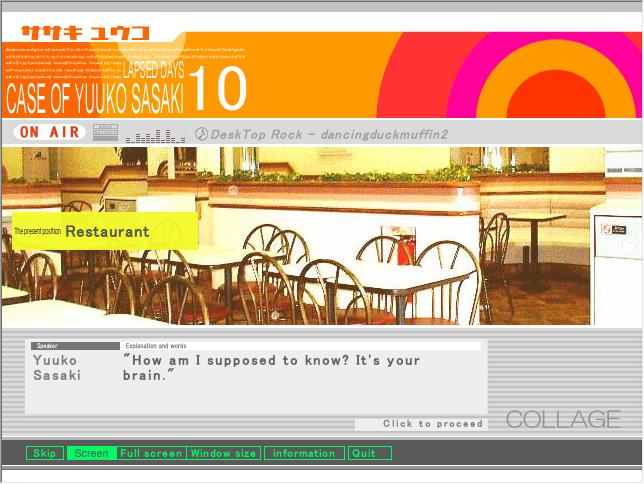
Some of the non-Yuuko commentary comes in the form of other characters sharing their thoughts on Yuuko. In this way, Collage shows variety despite generally being subdued and within a certain, defined, range.
While my impressions of Collage are positive in the main, I did have some issues with its presentation.
The six-year old Maria Sakamaki is not one of the three view-point characters, but she is one of the most important characters in Collage. While she is endearing and sympathetic, her manner of speaking is not that of a six year old. Maria not only uses a sophisticated vocabulary on par with Collage’s intelligent adults, but she uses it to express abstract ideas and sentiments which sometimes makes the adults see a situation in a new way.

Writing children characters in interesting ways is tricky, and there are cases where giving children an implausibly sophisticated vocabulary may benefit a work as a whole. (See a good anime case of getting it right in my Usagi Drop review.) But Maria’s centrality to some important events in Collage makes the fact that she is never written as a six-year old a bit jarring.
Collage is well-paced on the whole, but some events felt like they moved a bit too quickly in light of the fact that the majority of the story is confined to a couple of weeks. This is particularly noticeable in a central point of Miki’s arc (it should have started a bit further along) and a ongoing event in Yuuko’s. However, while some events feel rushed, this is understandable in light of the fact that Collage entails a somewhat compressed story in order to show readers three different character perspectives. The issues, while worth noting, are not too serious.
Finally, while one can extract a central message from Collage and its presentation, I would have liked to see the author express it a bit more clearly. All of the characters in Collage are in better places at the end than they were at the beginning, and – with a notable exception of one main character – they resolve their main specific concerns from the start of the story. But the ending, which we see from Yuuko’s perspective, feels a bit abrupt. Yuuko tells us how things are progressing, but it would have been more satisfying to have a final scene bringing the stories to a close and highlighting how the end of Collage is really a new beginning for the entire cast.
Overall Review
Collage is one of the most creative visual novels translated for al|together. It is also notable for the creator’s attention to detail in all respects, from its audio-visual presentation to the careful handling of the three character perspectives. While its story is simple, I doubt that any al|together-translated novel required more careful plotting and planning.
Collage is one of the easiest visual novels from al|together to recommend for general audiences – provided said general audiences can get it to run properly. It is a down-to-Earth, grown-up work, and I venture that readers will find parts of it relatable, whether to their own lives or to the stories of people they know. Collage is entirely lacking in the sorts of tropes which may otherwise put off people who are not fans of Japanese visual novels in general. While it is very much a work aimed at adults and older readers, the content is appropriate for all ages (albeit probably a bit dull for kids).
Collage is not a perfect work. Some story-lines were forced to move too quickly by the game’s events being confined to a short period, which in turn was likely a cost of telling the same story from three perspectives. Certain threads should have started a bit further along than they did. On the whole, despite the fact that Collage is a long al|together visual novel, it would have benefited from being longer than it was (maybe we can get the old development team back for a commercial re-master?). But on the whole, I found Collage to be refreshing, stylish, and well worth while. It is one of the finest works submitted to al|together and I hope this review prompts some New Leaf Journal readers to give it a try.